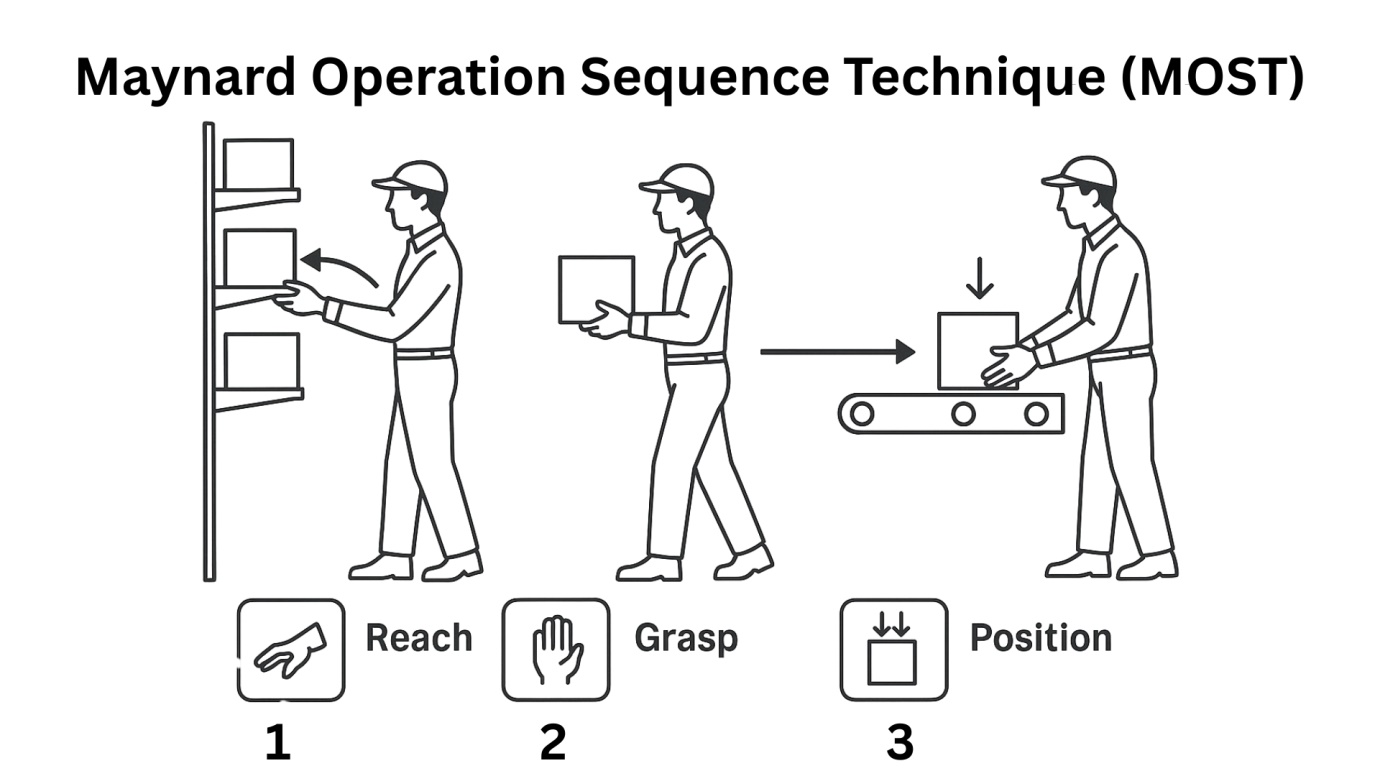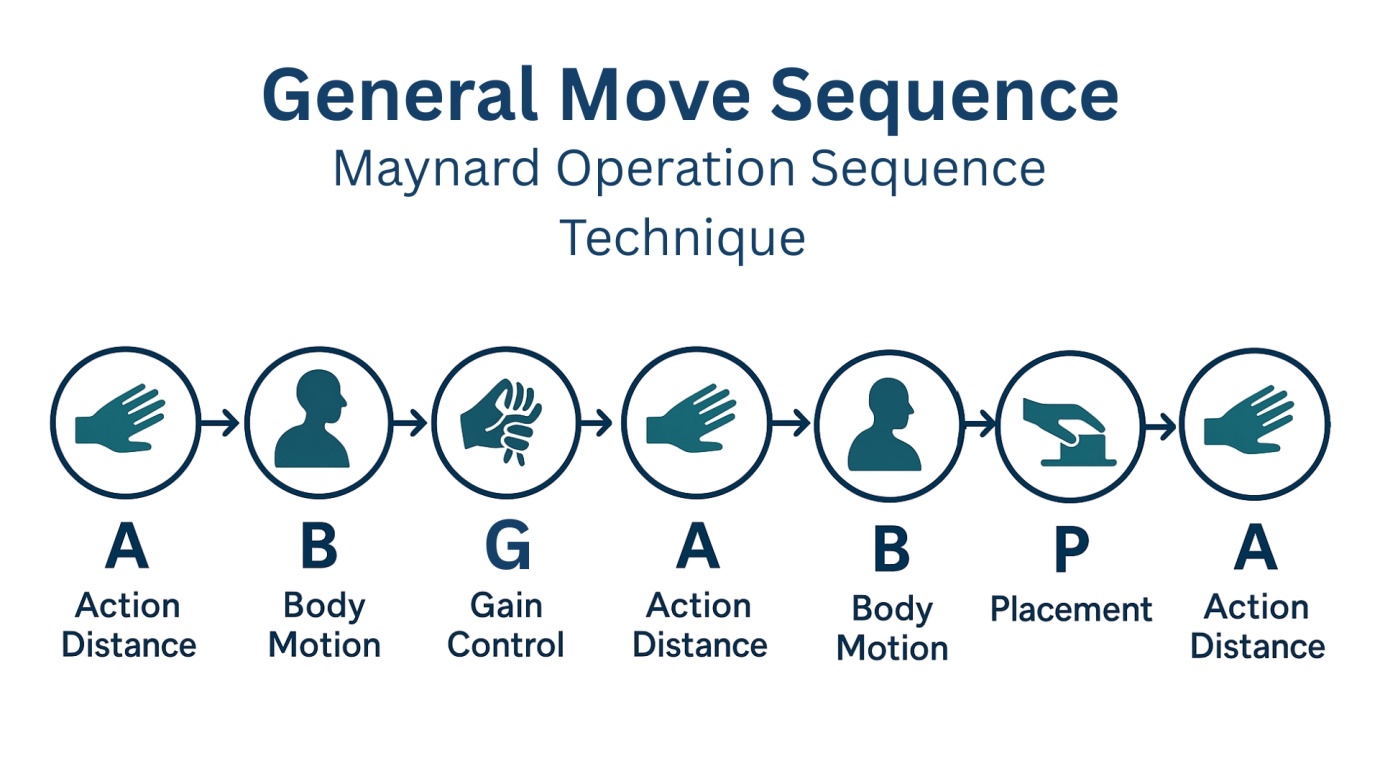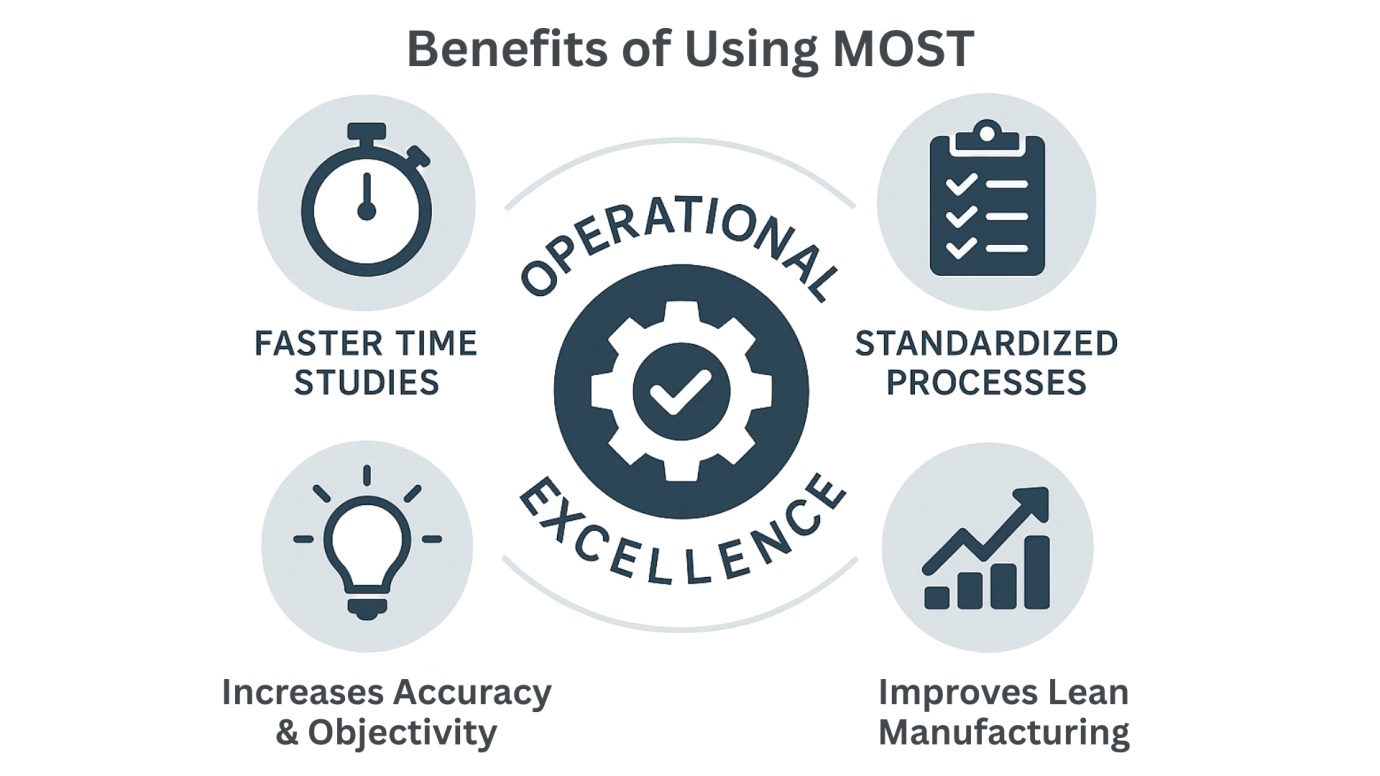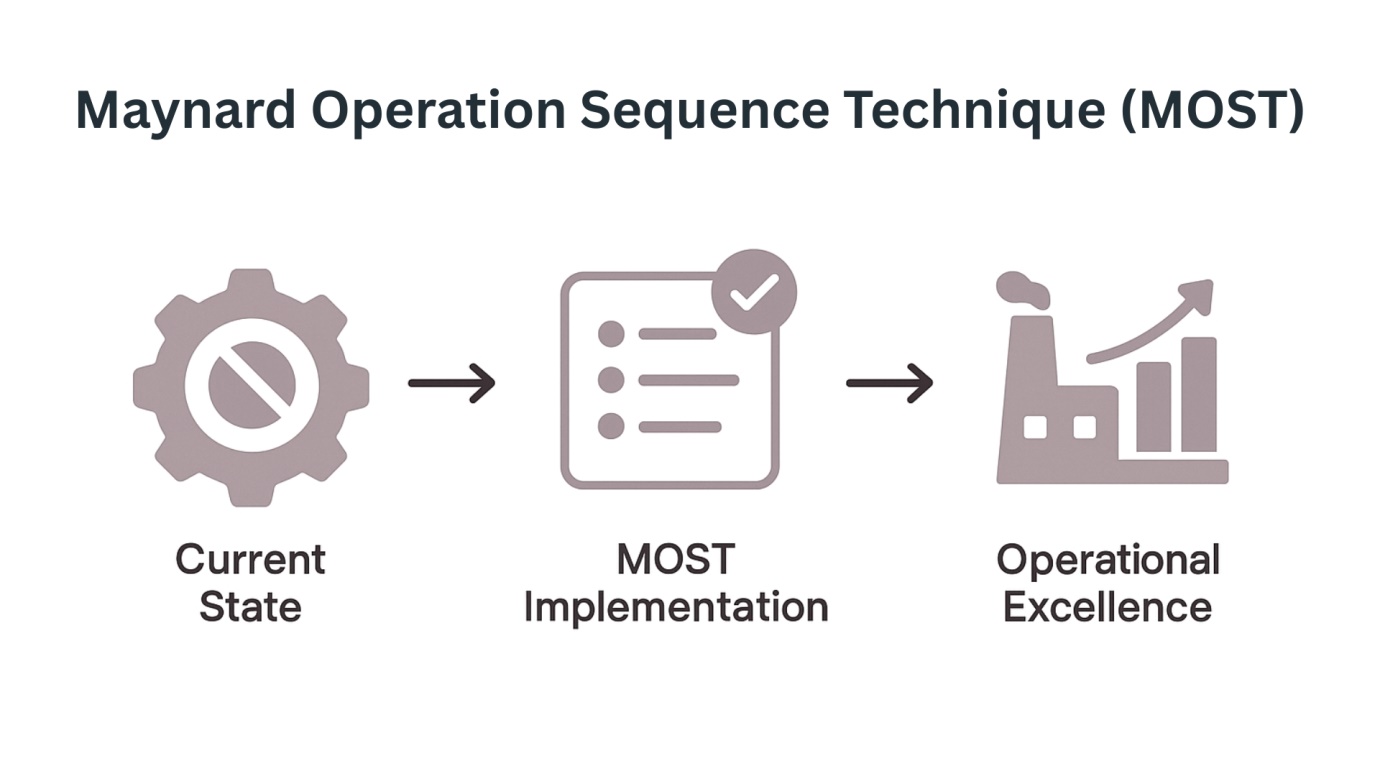Maynard Operation Sequence Technique (MOST)
Maynard Operation Sequence Technique (MOST): A Smarter Way to Measure Work Efficiency
In the fast-paced world of industrial engineering, work measurement plays a critical role in improving productivity, optimizing labor, and reducing operational costs. Traditional approaches like stopwatch-based time studies, while useful, often fall short in terms of accuracy, consistency, and scalability across large operations. This is where the Maynard Operation Sequence Technique—commonly known as MOST—steps in as a game-changing solution.
The Maynard Operation Sequence Technique is a revolutionary system that allows engineers and process managers to measure work using a predetermined set of motion sequences. Unlike manual time tracking, which can be subjective and error-prone, MOST provides a standardized and reliable method for evaluating task performance. It focuses on MOST motion study, which breaks down common physical activities into defined patterns and assigns time values based on real-world data.
One of the most compelling benefits of MOST is its ability to drastically reduce the time needed for a MOST time study. While traditional time study methods can take hours—or even days—MOST delivers results up to ten times faster, without compromising on accuracy. This makes it ideal for companies looking to scale operations, streamline workflows, and achieve continuous improvement across production lines.
As industries move toward data-driven decision-making and lean manufacturing practices, adopting tools like the Maynard Operation Sequence Technique becomes not just beneficial but essential. In this blog, we’ll explore how MOST works, its different types, real-world applications, and why it’s the modern alternative every manufacturing and operations team should consider.
What is the Maynard Operation Sequence Technique (MOST)?
In modern manufacturing and industrial operations, the need for speed, accuracy, and standardization in measuring human work is greater than ever. Enter the Maynard Operation Sequence Technique, or MOST, a powerful work measurement system designed to overcome the limitations of traditional time study methods.
MOST is a type of Predetermined Motion Time System (PMTS), which means it doesn’t rely on stopwatches or real-time observation. Instead, it uses a structured approach where common human motions are grouped into predefined sequences. These sequences are then assigned standard time values, making the MOST time study process both consistent and efficient.
History and Background
- The Maynard Operation Sequence Technique was developed by H. B. Maynard & Co. in the 1960s.
- It was created to simplify and speed up the analysis of manual tasks in industrial environments.
- It emerged as a more efficient alternative to detailed systems like Methods-Time Measurement (MTM), which were often time-consuming.
What Sets MOST Apart
Unlike traditional methods that require observing and timing each task manually, MOST:
- Uses predetermined motion sequences to represent work activity.
- Assigns time values in Time Measurement Units (TMUs), eliminating stopwatch use.
- Focuses on larger motion blocks, making MOST motion study significantly faster than micromotion studies.
- Enables standardization across jobs, teams, and locations.
Why MOST Matters
The real power of the Maynard Operation Sequence Technique lies in its ability to:
- Eliminate human bias from time measurement.
- Reduce analysis time by as much as 90% compared to traditional stopwatch studies.
- Provide reliable and repeatable data for continuous improvement initiatives.
Whether you’re running a high-speed assembly line or evaluating complex manual tasks, the MOST time study approach helps you capture accurate labor standards without the hassle of constant observation. It’s a smart, scalable solution that aligns perfectly with lean manufacturing and Six Sigma practices.
MOST vs. Traditional Time Study Methods
In the world of industrial engineering and process optimization, choosing the right method for evaluating work efficiency can significantly impact productivity and cost-effectiveness. Traditional approaches like stopwatch-based time studies and Methods-Time Measurement (MTM) have long been used to measure manual tasks. However, modern techniques like the Maynard Operation Sequence Technique—or MOST—are proving to be faster, more consistent, and far more scalable.
The primary difference lies in how work is observed, recorded, and analyzed. Traditional time studies often rely on manual observation using a stopwatch, introducing human error and inconsistency. MTM, while more detailed, is often too time-intensive for widespread use. In contrast, MOST time study methods use predefined motion sequences and time values to eliminate subjectivity and speed up the entire process.
Comparison Table: MOST vs. Traditional Methods

Why MOST Outperforms Traditional Methods
- Speed: A key advantage of the MOST time study is how quickly it can be applied. Where traditional methods may take hours, MOST analysis can be completed in a fraction of the time—without sacrificing accuracy.
- Consistency: Because it’s based on a standard set of motion patterns, MOST motion study removes the variability that comes from different observers or different time periods.
- Scalability: Whether it’s a small production line or a global manufacturing operation, the Maynard Operation Sequence Technique allows for fast implementation across the board.
- Objectivity: Since no stopwatch is involved, MOST ensures unbiased time values for every motion involved in a task.
In summary, the Maynard Operation Sequence Technique gives you the best of both worlds—speed and precision. For industries striving to improve efficiency and embrace lean practices, adopting MOST is not just a competitive advantage; it’s becoming a necessity. For a deeper look at how MOST compares with other time and motion study methods, check out our detailed blog on Comparison of Various Time Motion Studies.
How MOST Works: Understanding the Motion Sequences
At the heart of the Maynard Operation Sequence Technique lies a logical and structured approach to analyzing manual work. Instead of observing random activities, MOST (Maynard Operation Sequence Technique) breaks down human motions into defined, repeatable patterns. These motion patterns are grouped into sequences, each representing a typical action performed during a task.
This structure makes the most motion study system easy to apply and highly consistent across different industries and work environments.
The General Move Sequence: A Standard in MOST
One of the most commonly used motion sequences in MOST is the General Move sequence, applied when a task involves moving an object freely through the air — such as picking up a part and placing it on a shelf. The General Move follows this format:
A B G A B P A
Each letter in this sequence represents a specific motion element, and understanding them is key to grasping how MOST functions:
Breakdown of the General Move Motion Elements
- A – Action Distance: This element represents how far the hand or object moves. Whether it’s a short reach across a desk or a long stretch to a high shelf, Action Distance defines the time value based on distance.
- B – Body Motion: Includes any necessary body movement like bending, turning, or stepping. This element is critical in a most motion study, especially when assessing ergonomics.
- G – Gain Control: This describes the action of grasping or securing the object. It could involve picking up a lightweight item or using tools to get a firm hold.
- P – Placement: Refers to the final positioning of the object. Whether it’s setting down a box, aligning a part precisely, or inserting something into a slot, Placement matters in both timing and accuracy.
Each of these elements is assigned a specific TMU (Time Measurement Unit) value based on the complexity and effort involved. TMUs are the universal measurement unit in the maynard operation sequence, where 1 TMU = 0.036 seconds. This standardization makes time analysis objective and repeatable—two critical components of any successful most motion study.
Using the Maynard Operation Sequence Technique Chart
To simplify application, practitioners refer to a Maynard Operation Sequence Technique chart, which provides predefined time values for each motion element and its variation. This chart serves as a quick reference guide and eliminates the need for subjective timing.
The chart is structured to support the quick and effective breakdown of tasks using:
- Predetermined sequences like General Move, Controlled Move, and Tool Use.
- Time blocks in TMUs for every variation of motion.
- Logical combinations of motion elements based on task type.
By systematizing motion analysis through sequences and TMUs, MOST offers a universal language for measuring work—eliminating guesswork and aligning perfectly with lean manufacturing and Six Sigma initiatives.
Benefits of Using MOST
Adopting the Maynard Operation Sequence Technique in industrial and manufacturing settings offers a wide range of practical advantages. Designed as a highly efficient work measurement system, MOST empowers organizations to streamline operations, boost productivity, and enhance overall process quality.
Whether you’re managing a high-speed production line or optimizing manual workflows in logistics, the use of MOST delivers results that traditional time study methods simply can’t match.
1. Reduces Time Study Duration by Up to 90%
One of the most compelling benefits of the most time study approach is the dramatic reduction in time required to evaluate manual tasks. Unlike traditional stopwatch studies that demand hours of live observation, MOST uses predefined motion sequences and Time Measurement Units (TMUs) to estimate task durations quickly and efficiently.
- Analysts can complete a detailed task analysis in a fraction of the time.
- Time savings translate into faster decision-making and quicker process improvements.
This time efficiency alone makes the maynard operation sequence technique an essential tool for companies aiming for agile operations.
2. Increases Accuracy and Objectivity
Because MOST is built on standard motion sequences and fixed TMU values, it eliminates much of the subjectivity found in manual time studies. This increases both the accuracy and repeatability of your data.
- No performance rating or judgment calls needed.
- Consistent results across different analysts and locations.
- Aligns with global benchmarks and lean standards.
By applying the maynard operation sequence, organizations can achieve more reliable productivity assessments without relying on guesswork.
3. Encourages Standardization Across Tasks
Standardization is critical for scalability—and this is where MOST truly excels. Every task broken down through the maynard operation sequence technique follows a consistent structure, allowing businesses to compare and optimize work processes across departments, locations, or even countries.
- Easier to train employees using standard methods.
- Simplifies process documentation and audit compliance.
- Improves cross-functional efficiency.
Whether it’s for internal audits, quality control, or global expansion, using a most time study method ensures consistency and repeatability.
4. Improves Lean Manufacturing Practices
For companies implementing lean methodologies, MOST is a natural fit. It supports the identification and elimination of non-value-adding motions, making it easier to build streamlined workflows that enhance productivity.
- Helps eliminate motion waste and reduce cycle times.
- Facilitates continuous improvement initiatives (Kaizen).
- Provides data-driven insights for layout and workflow design.
The structured nature of the maynard operation sequence aligns seamlessly with lean principles—making MOST a key enabler of operational excellence.
The benefits of adopting MOST go far beyond time savings. From increasing measurement accuracy to enhancing lean practices, the maynard operation sequence technique offers a complete, scalable, and modern approach to industrial work measurement. For organizations serious about efficiency, quality, and growth, integrating the maynard operation sequence is not just an option—it’s a competitive advantage.
How Sugoya India Applies MOST
At Sugoya India, we specialize in empowering organizations to achieve operational excellence through proven industrial engineering methodologies. One of our core competencies lies in the implementation of the Maynard Operation Sequence Technique—or MOST—a transformative system that redefines how manual work is measured, analyzed, and optimized.
By leveraging our expertise in most time study and motion analysis, we help manufacturers, logistics providers, and process-driven industries unlock new levels of productivity, standardization, and lean efficiency.
Our Expertise with the Maynard Operation Sequence Technique
At Sugoya India, we take a strategic and hands-on approach to applying the maynard operation sequence technique across a variety of industries. Our engineers and consultants are trained in the practical application of MOST, ensuring accurate and scalable results.
Here’s how we support your organization:
- Complete MOST Implementation: From work sampling to process optimization, we manage the entire lifecycle of your most motion study.
- Process Mapping Using MOST: We deconstruct every task into defined motion sequences to create accurate labor standards using TMUs.
- Customized Time Standards: Our team conducts in-depth most time study sessions tailored to your industry and operational requirements.
Training, Consultation & Implementation Support
We offer a comprehensive suite of services to ensure that your team fully understands and applies the maynard operation sequence technique effectively:
- MOST Training Workshops: Onsite and virtual sessions designed for operations managers, IE professionals, and quality teams.
- Consultation Services: Hands-on guidance to integrate MOST into your work measurement strategy.
- On-Ground Implementation Support: Real-time assistance during pilot projects or full-scale rollout of most time study initiatives.
Whether you’re just exploring MOST or planning to deploy it company-wide, Sugoya India ensures you’re equipped with the right knowledge and tools.
Integrated Work Study & Lean Services
Our services don’t stop at most motion study. Sugoya India also provides:
- Comprehensive Work Study Programs
- Lean Manufacturing Audits & Gap Assessments
- Industrial Engineering & Productivity Training Modules
- Continuous Improvement and Kaizen Support
By combining the power of MOST with holistic lean methodologies, we deliver lasting impact on your bottom line.
If you’re looking to reduce waste, improve productivity, and bring consistency to your manual operations, MOST is the way forward—and Sugoya India is your trusted partner. Schedule a consultation with our experts today and discover how the maynard operation sequence technique can transform your operations.
FAQs
A. The Maynard Operation Sequence Technique, commonly known as MOST, is a predetermined motion time system (PMTS) used to analyze and improve manual work by breaking down tasks into standard motion sequences. It enables faster and more consistent work measurement than traditional time studies.
A. A most motion study is used to evaluate manual tasks by analyzing actions like reaching, grasping, and moving items. It helps organizations optimize workflow, reduce waste, and improve productivity using standardized motion sequences.
A. The maynard operation sequence technique was developed by H.B. Maynard & Co. in the 1960s to provide a more efficient and scalable method of work measurement.
A. TMUs (Time Measurement Units) are the building blocks of a most time study, allowing tasks to be quantified with high precision. One TMU equals 0.036 seconds and is used to assign time values to each motion.
A. Yes, MOST is an ideal tool for lean manufacturing. It supports waste reduction, standardization, and continuous improvement—all essential principles of lean methodology.
A. Yes, various maynard operation sequence technique software solutions are available that allow engineers to model, analyze, and simulate tasks using digital MOST tools.
A. Industries like automotive, electronics, logistics, construction, and manufacturing all benefit from most analysis because of its flexibility, accuracy, and scalability.
A. A simple most time study example could involve analyzing a warehouse worker who picks up a box and places it on a conveyor. Using MOST, each movement (reach, grasp, move, place) is evaluated with predefined TMUs for accurate measurement.
A. By using motion sequences defined in the maynard operation sequence technique chart, MOST ensures that similar tasks are measured in the same way across teams and locations, supporting global standardization.
A. Sugoya India offers consultation, training, and on-site support for companies adopting the maynard operation sequence technique. We also provide guidance on most motion study and work measurement best practices.

Conclusion
In today’s fast-paced and efficiency-driven industrial landscape, the ability to measure, analyze, and improve manual work processes is no longer optional—it’s essential. This is where the Maynard Operation Sequence Technique, or MOST, proves to be an invaluable asset for organizations aiming to stay ahead of the curve.
Unlike traditional time studies that rely on stopwatches and subjective performance ratings, MOST offers a standardized and highly scalable approach to work measurement. By focusing on motion patterns and assigning consistent time values through Time Measurement Units (TMUs), a most time study becomes faster, more accurate, and significantly more reliable.
With its structured methodology, most motion study enables businesses to identify inefficiencies, streamline processes, and implement changes backed by data—not guesswork. From improving productivity on the shop floor to supporting lean manufacturing goals, the maynard operation sequence technique offers a comprehensive framework for achieving operational excellence.
At Sugoya India, we’ve seen firsthand how the implementation of MOST transforms operations, reduces waste, and fosters a culture of continuous improvement. Whether you’re optimizing a single workstation or scaling productivity across multiple sites, the power of MOST is undeniable.
Ready to Optimize Your Workforce? Let’s Talk!
If you’re serious about improving efficiency, reducing costs, and standardizing work across your organization, now is the time to adopt the maynard operation sequence technique. Let MOST be the driving force behind your operational success.
Contact us now to learn more or to book your most time study session with our certified consultants.
To learn more about Sugoya India and our expert consultation services, visit our Homepage.
Disclaimer:
The information provided in this blog post regarding the Maynard Operation Sequence Technique (MOST) is for general informational purposes only. All information on the site is provided in good faith, however, we make no representation or warranty of any kind, express or implied, regarding the accuracy, adequacy, validity, reliability, availability, or completeness of any information on the site.

